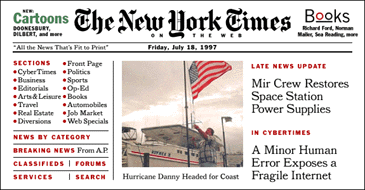Site Covers
Site covers can serve a number of different
purposes. Some function as "splash" screens that offer little
information, but are intended to entice users into a site by using snazzy
graphics or effects. Others are used to establish an overall "look-and-feel"
for a site. Such covers often provide links to the major sections of the site,
allowing visitors quick access to topics of interest while providing a general
site overview. Other covers have few graphics, but provide detailed information
and access to the content of the site. Which type of cover is most effective is
dependent on the nature and purpose of the site.
We have found covers to be the most controversial of all site elements. For many
readers, site covers are simply an additional and annoying mouse click between
them and the content they are seeking. Such readers would like be presented
with a site index at the start rather than pretty graphics or spiffy
animations. The key is to assess your audience and then choose the entry that
seems most appropriate.
Also, consider the function of your site. Is your typical visitor there for a single
visit or will they visit often? An on-line tool like a calendar or search
engine should not have a purely aesthetic site cover, as visitors will visit
the site perhaps several times a day. An elegant but non-functional cover on
such a site will quickly become tedious. Of course, visitors who do not want to
enter through the front door can simply bookmark an internal page of your site,
for example, the table of contents. But if you find yourself repeatedly making this
argument for using a site cover, you may want to adapt or even
remove your cover to better accommodate your audience.
Information
An informational site, such as an academic, corporate, or general interest
site, should have a cover that establishes an overall visual design theme or
metaphor for the site. It should also identify and give a brief explanation of
the purpose of the site, and provide a site overview by presenting links to its
major sections. This type of cover should answer the questions, Where am I?
What is it like here? What do these people do? What kind of stuff will I find?
 Graphic has been reduced from the original size. www.nytimes.com
Graphic has been reduced from the original size. www.nytimes.com
Reference
A site that will be used as a reference should have its menu posted right on
the front door. Visitors should be able to tell at a glance if the information
they are seeking is inside, and, if so, exactly where to find it. A cover to a
reference site should look more like a table of contents, with links to every
page in the site. This type of cover can have graphic elements, but their role
is secondary to the content and access links. Graphics should be modest, and
should establish a site identity that is maintained throughout all pages. This
type of cover should answer the questions, Do they have a page on wildebeests?
How do I get there right now?
 Graphic has been reduced from the original size. www.yahoo.com
Graphic has been reduced from the original size. www.yahoo.com
All the rest
The third type of site cover is one that elicits questions that can be answered
only by entering the site. These covers use animations, graphics, and/or
multimedia to pique interest and draw visitors into the main body of the site.
The success of these covers depends enormously on the expectation of the site
visitor. If you visit a site about a poet, you will enter with a different
expectation than when visiting a site about carpal tunnel syndrome. Visitors to
a site about poetry may not simply be out Web foraging, but may instead be
looking for an experience, for art, for entertainment. A mysterious, enigmatic,
aesthetically-pleasing facade might just entice such visitors in.



Jones & Jones, Architects and Landscape Architects

|
www.jonesandjones.com
Choose wisely
With site covers, more than with any other aspect of Web site design, you must
carefully gauge the needs and expectations of your audience. Too much splash on
a reference site will exasperate, too little splash on an entertainment site
will bore. And first impressions are what matters most, particularly when there
are so many other fish in the sea.
References
Siegel, D. 1996. Creating killer web sites. Indianapolis: Hayden Books.
|